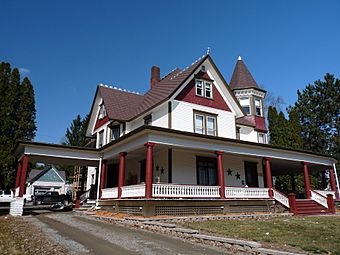Charles and Theresa Cornelius House facts for kids
Quick facts for kids |
|
|
Charles and Theresa Cornelius House
|
|

Charles and Theresa Cornelius House
|
|
| Location | 118 Clay St. Neillsville, Wisconsin |
|---|---|
| Built | 1909 |
| Architect | Anton F. Billmeyer |
| Architectural style | Queen Anne |
| NRHP reference No. | 13000749 |
| Added to NRHP | October 18, 2013 |
The Charles and Theresa Cornelius House is a special old home located in Neillsville, Wisconsin. It's known for its beautiful design and interesting past.
The Charles and Theresa Cornelius House
This house was once the home of Charles and Theresa Cornelius. Charles Cornelius was an important person in his community. He was a successful businessman and also worked as a banker. This meant he helped people with their money and investments. The house itself was built in 1909. It shows off a style of building called Queen Anne architecture, which was popular a long time ago.
A Look at Its Past
After Charles Cornelius passed away, the house changed hands and purposes several times. For a while, it was used as a funeral home. This is a place where services are held for people who have died. Later, the large house was divided into smaller apartments, where different families could live.
However, people eventually wanted to bring the house back to its original purpose. They worked to change it back into a single home for one family. This effort helped to preserve its history and unique features.
Becoming a Historic Landmark
Because of its history and special architecture, the Charles and Theresa Cornelius House was recognized as an important building. In 2012, it was added to the State Register of Historic Places. This list includes buildings and sites that are important to the history of Wisconsin.
The very next year, in 2013, it received an even bigger honor. It was added to the National Register of Historic Places. This is a list of places across the entire United States that are considered important to the country's history. Being on this list helps protect the house and makes sure its story can be shared for many years to come.

